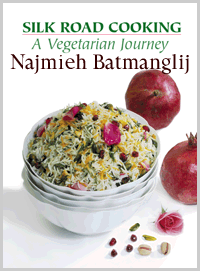 Nuts about fruits Nuts about fruits
What fruits and nuts to eat in ancient Persia?
For Houshang A'lam
Touraj Daryaee
September 12, 2005
iranian.com
This is a less specialized paper. I would like to thank M. Naraghi and I. Madadi for providing me with information on fruits in the Persian world; F. Pakzad for his transcription of the Bundahisn; and W. Soward for reading the manuscript and making constructive remarks.
***
If we knew as much about the culture of ancient Iran as about ancient Egypt or Babylonia, or even as much as about India or China, our notions of cultural development in Asia would probably be widely different from what they are at present.
-- B. Laufer, Sino-Iranica, 1919, p. 185
If you are Persian there is a 99.9% chance that at least once or probably many times you have heard these sayings:

"Eat some fruit..."
"Should I peel a cucumber for you?"
"Have some pistachios..."
 Even the Immigration officers at the Los Angeles International Airport (LAX) know the Persian word for pistachio and ask you if you have any. And even though there are plenty of pistachios available at the Persian markets in Westwood, you still are obliged to carry them from Tehran and maybe pay for your overweight luggage because of them. Even the Immigration officers at the Los Angeles International Airport (LAX) know the Persian word for pistachio and ask you if you have any. And even though there are plenty of pistachios available at the Persian markets in Westwood, you still are obliged to carry them from Tehran and maybe pay for your overweight luggage because of them.
My mother tells me that when her grandfather (my great grandfather) use to go to Tehran, two or three days a week to do his business he would buy 50 to 100 cucumbers from the Sabze Meydun, and by the time he had come home to Dezashib (Shemiran), his driver had to clean up the back seat as he had eaten some 40 of the cucumbers without salt!
My friend Mateo (Muhammad) eats cucumbers and lettuce religiously. When I stay with him, I have to go through the obligatory cucumber and lettuce eating ceremony in the afternoon and at midnight. Otherwise, I just hear him eating it over the phone while we are discussing world politics and Middle East Studies.
My other friend, Reza is well known to eat every piece of fruit that he can find when he visits someone’s home. We have had major bouts of melon eating ceremonies in Tehran and Los Angeles. His craving knows not bounds, as one day during our graduate days we ventured to Westwood Persian market to buy grapes in the windy and cold weather and were astounded when we realized that we just had paid $11.00 for a bag of grapes. We assumed they must be designer grapes and looked forward to eating them.
This is a Persian habit which our parents have taught us. There is a lot of talk about Persian or Iranian identity, and I would suggest that one characteristic would be such a habit. Interestingly, this appears to be part of Persian culture which seems to have a long history and it is not limited to the modern era.
 In this brief essay I would like to go back in time and see what fruits were eaten in ancient Persia and look at the way in which the Persians looked at fruits and how they classified them in antiquity. I believe these matters often are neglected in Persian Studies and need to be elucidated from the fragmentary evidence that exists for the period to better shed light on the culture of Persia >>> Full text & notes pdf In this brief essay I would like to go back in time and see what fruits were eaten in ancient Persia and look at the way in which the Persians looked at fruits and how they classified them in antiquity. I believe these matters often are neglected in Persian Studies and need to be elucidated from the fragmentary evidence that exists for the period to better shed light on the culture of Persia >>> Full text & notes pdf
About
Touraj Daryaee is
Professor of Ancient History at
California State University, Fullerton.
See:
faculty.fullerton.edu/tdaryaee/
TourajDaryaee.com
Sasanika.com
|